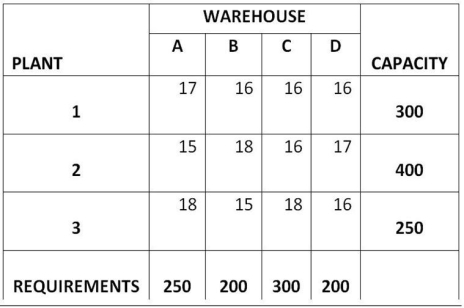Multiple Choice
Table 13.9
Sagebrush Company has four warehouses (A, B, C, and D) that require monthly shipments of 250, 200, 300, and 200 units per month, respectively. Its three plants (1, 2, and 3) have monthly capacities of 300, 400, and 250, respectively. Plant capacities, warehouse needs and shipping costs (in $) are shown in the following initial transportation method tableau. For example, the shipping cost from Plant 1 to Warehouse A is $17 per unit.

-Use the information in Table 13.9. What can be said about a plan that ships 200 units from 1 to A, 100 units from 1 to B, 100 units from 2 to B, 300 units from 2 to C, and 250 units from 3 to D?
A) It is not feasible in terms of plant capacities.
B) It is not feasible in terms of satisfying warehouse demands.
C) It is feasible, but not the least-cost allocation pattern.
D) It is the optimal solution.
Correct Answer:

Verified
Correct Answer:
Verified
Q79: The center of gravity method considers a
Q80: Table 13.2<br>A single facility is needed to
Q81: What is a dummy plant or warehouse
Q82: More than 80 percent of all relocations
Q83: Which of the following is an example
Q85: Quality of life issues include:<br>A) proximity to
Q86: Table 13.6<br>Union Fork, Inc. has five distribution
Q87: McKenna Restaurant wishes to open a new
Q88: Table 13.1<br>Four departments are located in adjacent
Q89: Table 13.2<br>A single facility is needed to